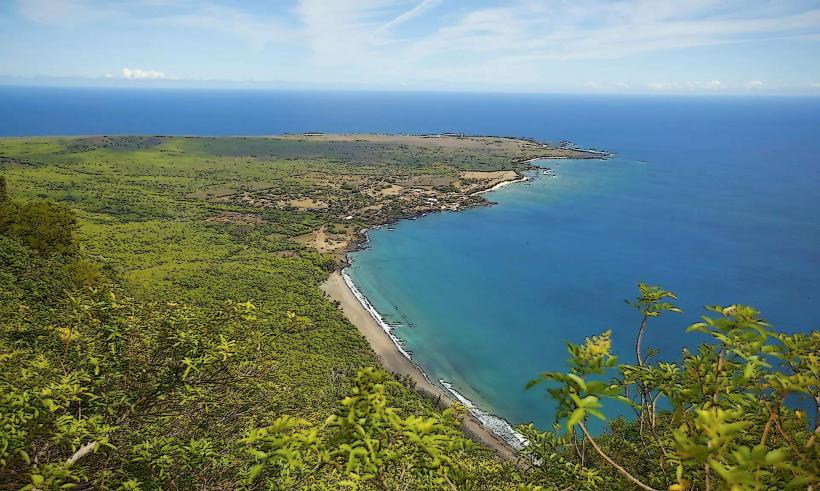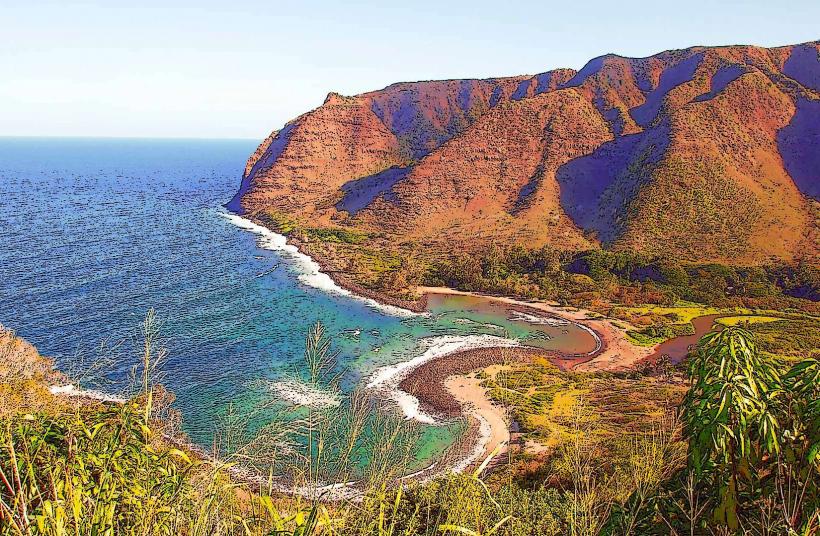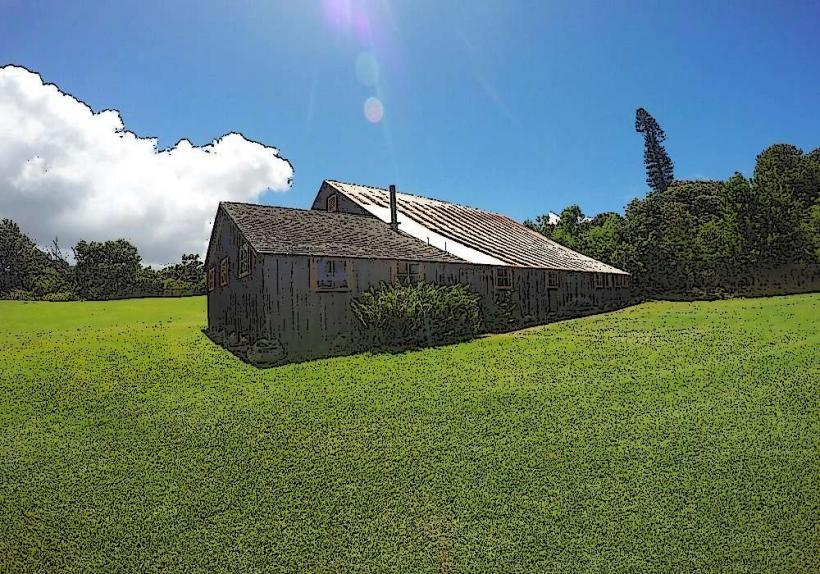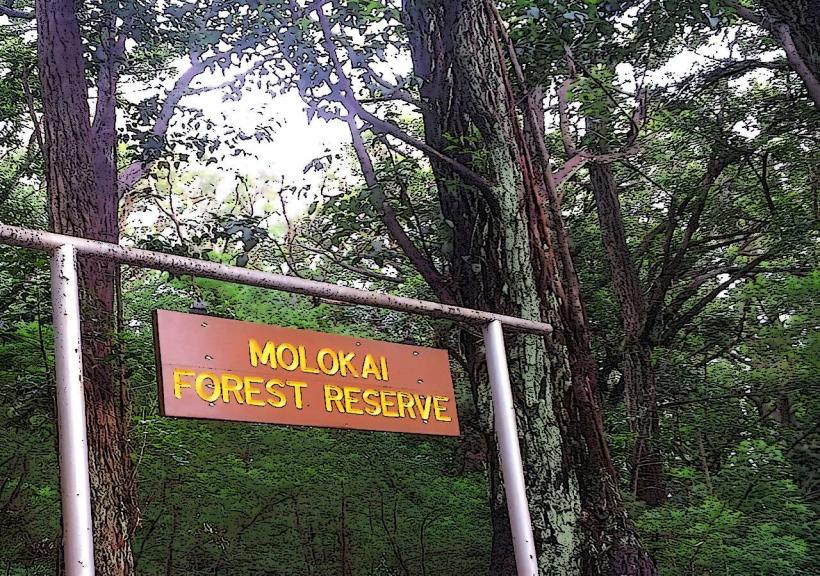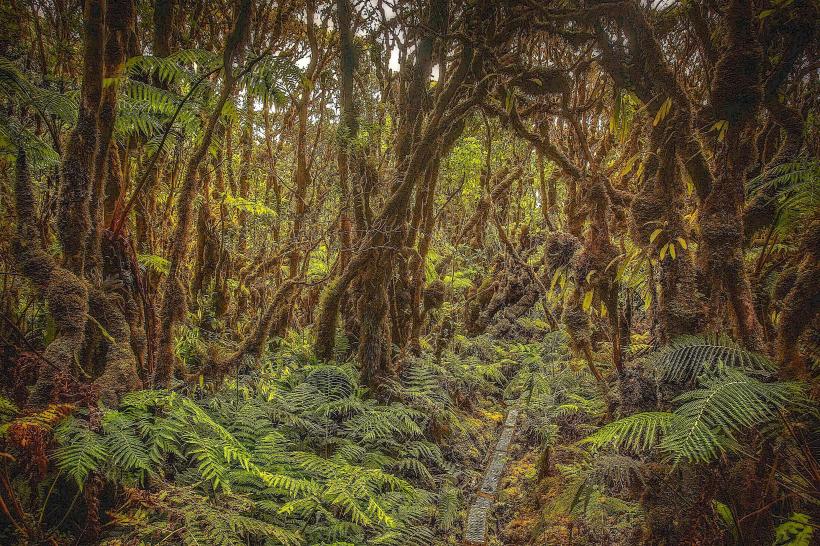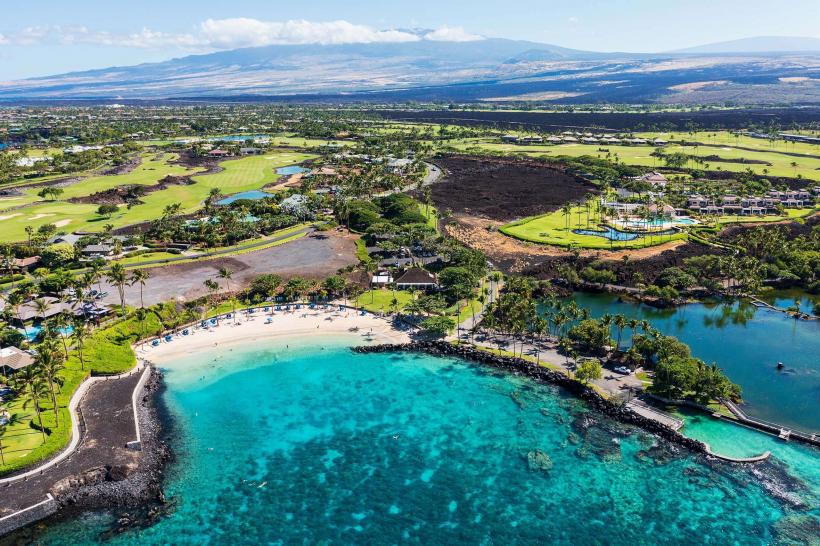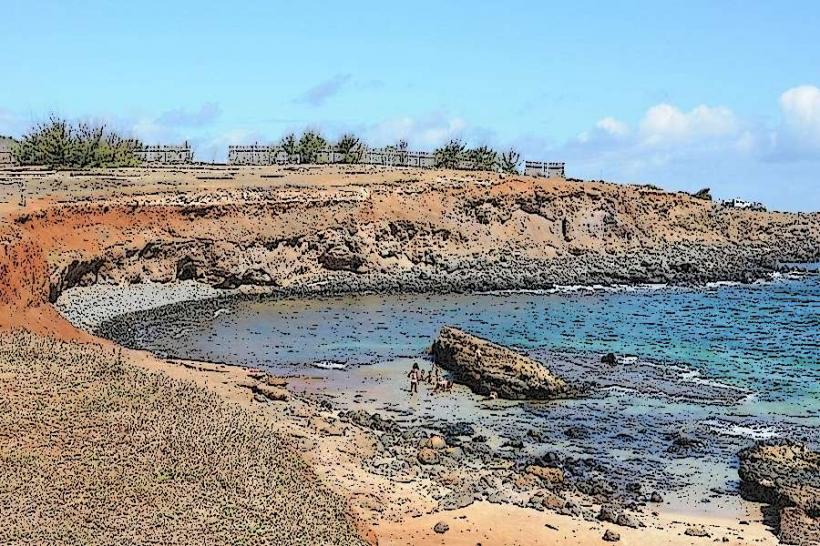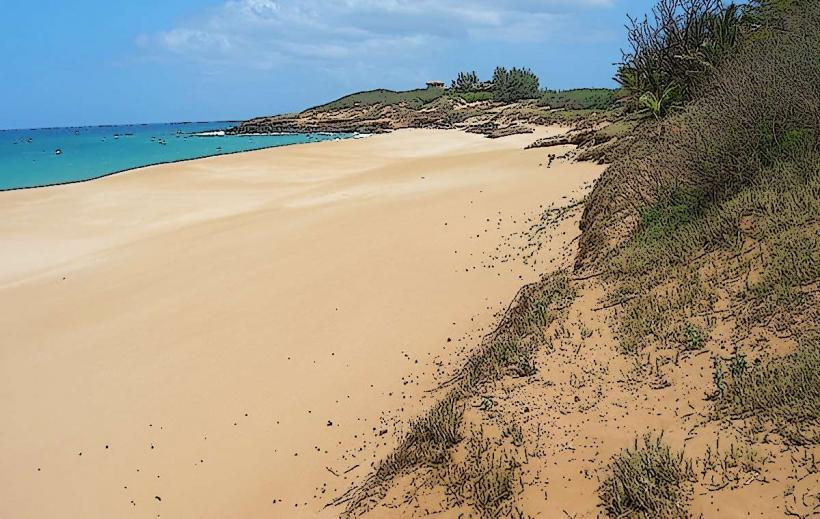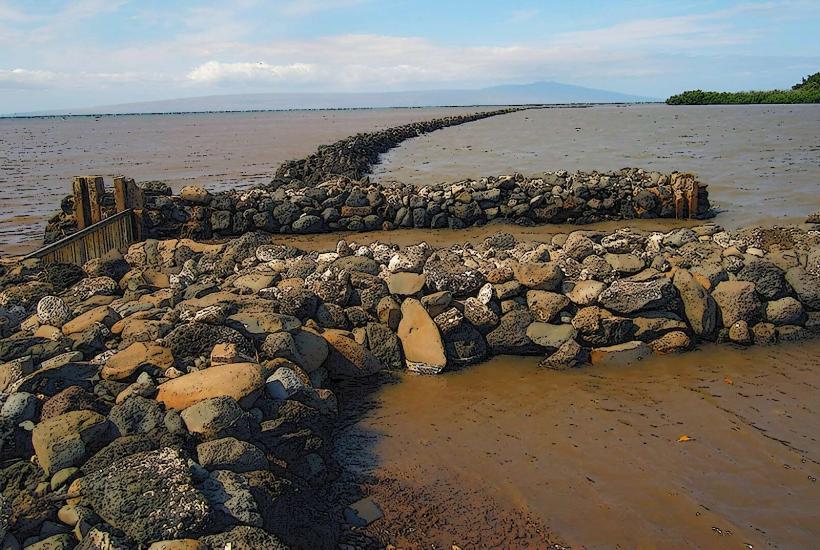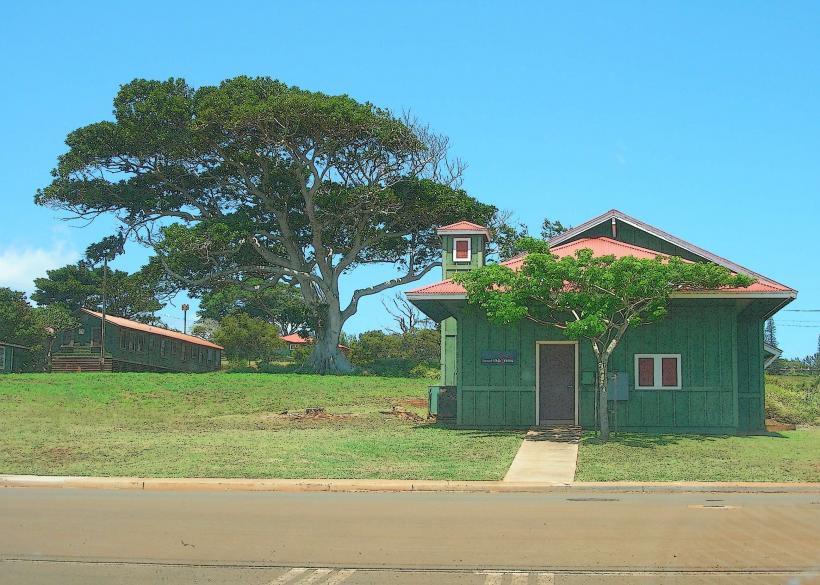Information
Landmark: Molokai Sea CliffsCity: Molokai
Country: USA Hawaii
Continent: North America
Molokai Sea Cliffs, also known as the Molokai Cliffs or Kalaupapa Cliffs, are some of the tallest sea cliffs in the world, standing at remarkable heights along the northern coast of Molokai, Hawaii. These cliffs are one of the island's most dramatic and awe-inspiring natural features, offering breathtaking views, a unique landscape, and a rich cultural and historical significance.
Key Features and Attractions:
1. Height and Geography:
- The Molokai Sea Cliffs rise up to 3,000 feet (914 meters) above the ocean in some places, making them the tallest sea cliffs in the United States and one of the tallest in the world. They stretch along the north shore of the island for about 12 miles (19 kilometers), creating a rugged and towering landscape that is truly remarkable.
- These cliffs were formed through volcanic activity and erosion, with the island’s ancient lava flows and the constant pounding of the ocean shaping the dramatic formations over millennia. The cliffs offer a sheer drop to the ocean below, where the waves crash against the base, creating stunning views and dynamic scenery.
2. Scenic Views and Photography:
- The Molokai Sea Cliffs are one of the most photographed and admired natural features of Molokai. The towering cliffs against the backdrop of the Pacific Ocean create a striking contrast, especially when bathed in the golden light of sunrise or sunset.
- The cliffs are visible from various parts of Molokai, and the views from the Kalaupapa National Historical Park, Pali Road, or from the sea are some of the most stunning on the island. The blue waters below, the steep cliffsides, and the vibrant greenery on the cliffs make for picturesque scenery that’s often considered one of the most beautiful on the Hawaiian Islands.
3. Kalaupapa National Historical Park:
- The Molokai Sea Cliffs are most famously seen from Kalaupapa National Historical Park, which is located at the base of the cliffs. The park can be accessed by plane or hiking from the top of the cliffs. Once at the bottom, visitors can explore Kalaupapa, the former leper colony, which is a historic site where people with Hansen's disease (leprosy) were quarantined for many years.
- The views of the cliffs from Kalaupapa are unparalleled, offering visitors a unique perspective of the landscape and an opportunity to reflect on the historical significance of the area.
4. Hiking and Adventure:
- Hiking to the Molokai Sea Cliffs is a popular activity, and the Kalaupapa Trail is the most well-known path that leads from the top of the cliffs down to the Kalaupapa settlement. This trail is challenging, with a 1,700-foot drop over 2.9 miles of terrain, making it suitable only for experienced hikers. The trail offers hikers incredible views of the cliffs, the ocean below, and the surrounding landscape.
- Aerial Tours are another popular way to experience the sea cliffs. Helicopter or small-plane tours provide a bird’s-eye view of the cliffs, the surrounding coastline, and the rugged, isolated beauty of Molokai's northern shore.
5. Unique Ecosystem:
- The Molokai Sea Cliffs are home to unique flora and fauna. The vegetation on the cliffs is a mixture of lush tropical plants, including native Hawaiian species, as well as some invasive plants. The steep terrain and harsh conditions limit access to the cliffs, which has helped preserve the ecosystems on them.
- The cliffs are also an important bird sanctuary. Various species of seabirds, including the ʻuaʻu (Hawaiian petrel) and iiwi (Hawaiian honeycreeper), nest in the inaccessible ledges of the cliffs. The cliffs' isolation and the absence of human activity have made them a vital habitat for these endangered species.
6. Cultural Significance:
- The Molokai Sea Cliffs are not just a natural wonder but also hold cultural significance for the Native Hawaiian people. They are part of the island's broader spiritual landscape, which includes sacred sites, traditional fishing areas, and other cultural landmarks.
- In Hawaiian culture, cliffs and other natural formations are often imbued with spiritual meaning, and the Molokai Sea Cliffs are seen as part of the island's identity and history. The cliffs' towering presence is symbolic of the strength and resilience of the people who live on the island.
7. Wildlife and Marine Life:
- The base of the Molokai Sea Cliffs is surrounded by clear waters, and visitors can spot a variety of marine life, including dolphins, sea turtles, and a variety of fish species. The waters off the cliffs are also popular for scuba diving and snorkeling, as the marine ecosystem is rich with life.
- The surrounding ocean waters are also an essential breeding ground for various species of whales. In the winter months, humpback whales can often be seen migrating through the waters off Molokai.
8. Molokai's Isolation and Preservation:
- Molokai, in general, is known for its low-key, traditional way of life, and the Molokai Sea Cliffs represent the island's wild and remote beauty. The isolation of the island has helped preserve its natural landscapes, and the Molokai Sea Cliffs are emblematic of the island's rugged and untamed character.
- The cliffs remain relatively untouched by tourism development compared to other Hawaiian islands. This makes them an important part of Molokai’s commitment to preserving its natural environment, culture, and way of life.
9. Access to Molokai Sea Cliffs:
- The Molokai Sea Cliffs are located on the north shore of Molokai, and visitors can experience them from several viewpoints. Pali Road offers a few lookout points with stunning views of the cliffs.
- For those interested in seeing the cliffs from below, the Kalaupapa Trail is a difficult but rewarding hike. Alternatively, helicopter tours from Molokai are available for an aerial view of the cliffs and the surrounding area.
10. Best Time to Visit:
- The best time to visit the Molokai Sea Cliffs is during the dry season from April to October when the weather is more predictable, and the hiking conditions are ideal. However, even during the rainy season, the cliffs and surrounding landscape remain stunning, though the weather can be more unpredictable, and some trails may be slippery.
- Early morning or late afternoon offers the best light for photography and for enjoying the peaceful atmosphere of the cliffs. The sunset views from the cliffs are particularly spectacular.
Conclusion:
The Molokai Sea Cliffs are one of Hawaii's most remarkable and awe-inspiring natural features. With their towering heights, dramatic landscapes, rich wildlife, and deep cultural significance, they represent the wild beauty of Molokai. Whether viewed from a hiking trail, a boat tour, or an aerial tour, the Molokai Sea Cliffs offer an unforgettable experience and a chance to witness the natural power and serene beauty of one of the world’s most impressive coastal formations.

